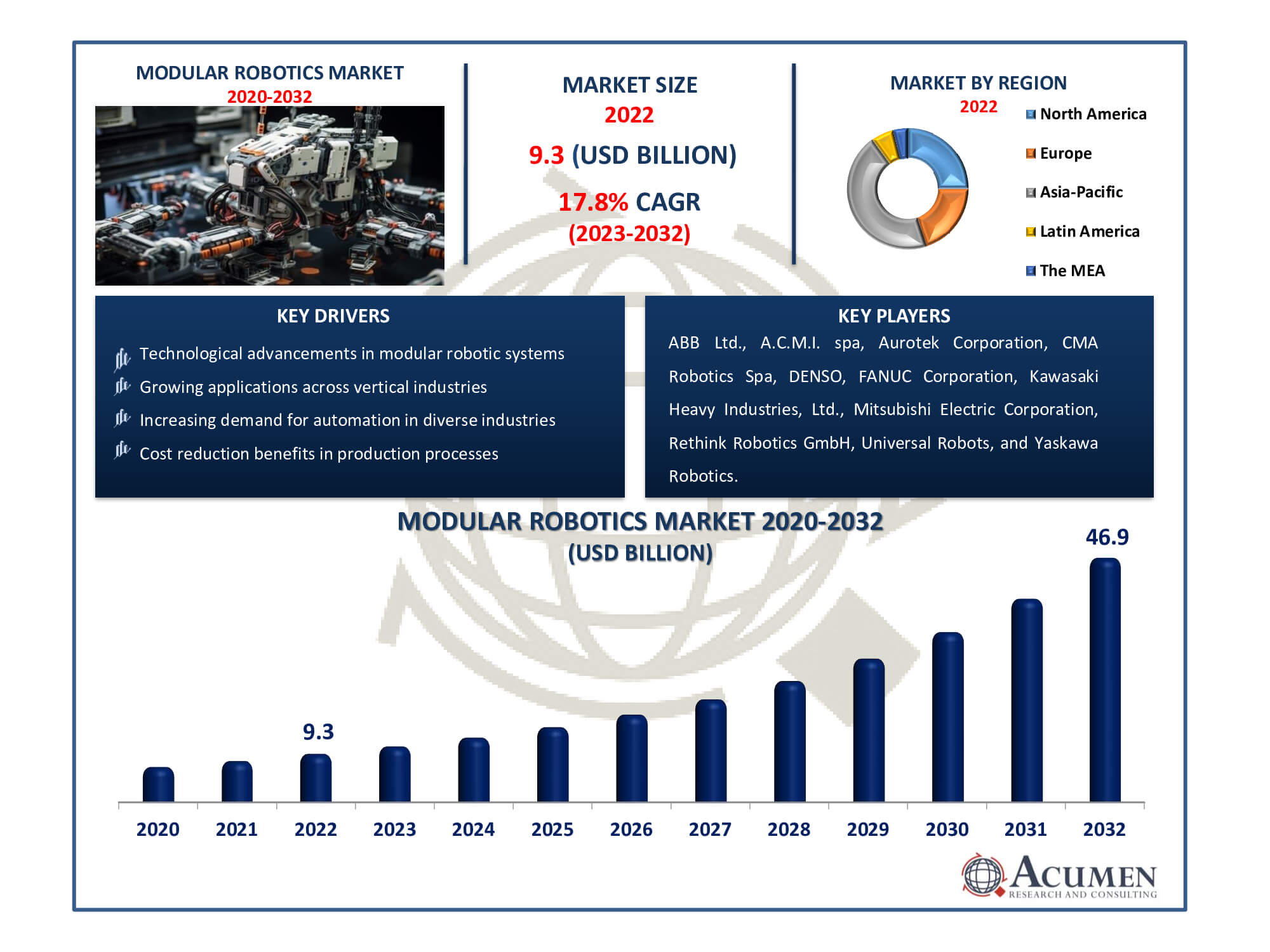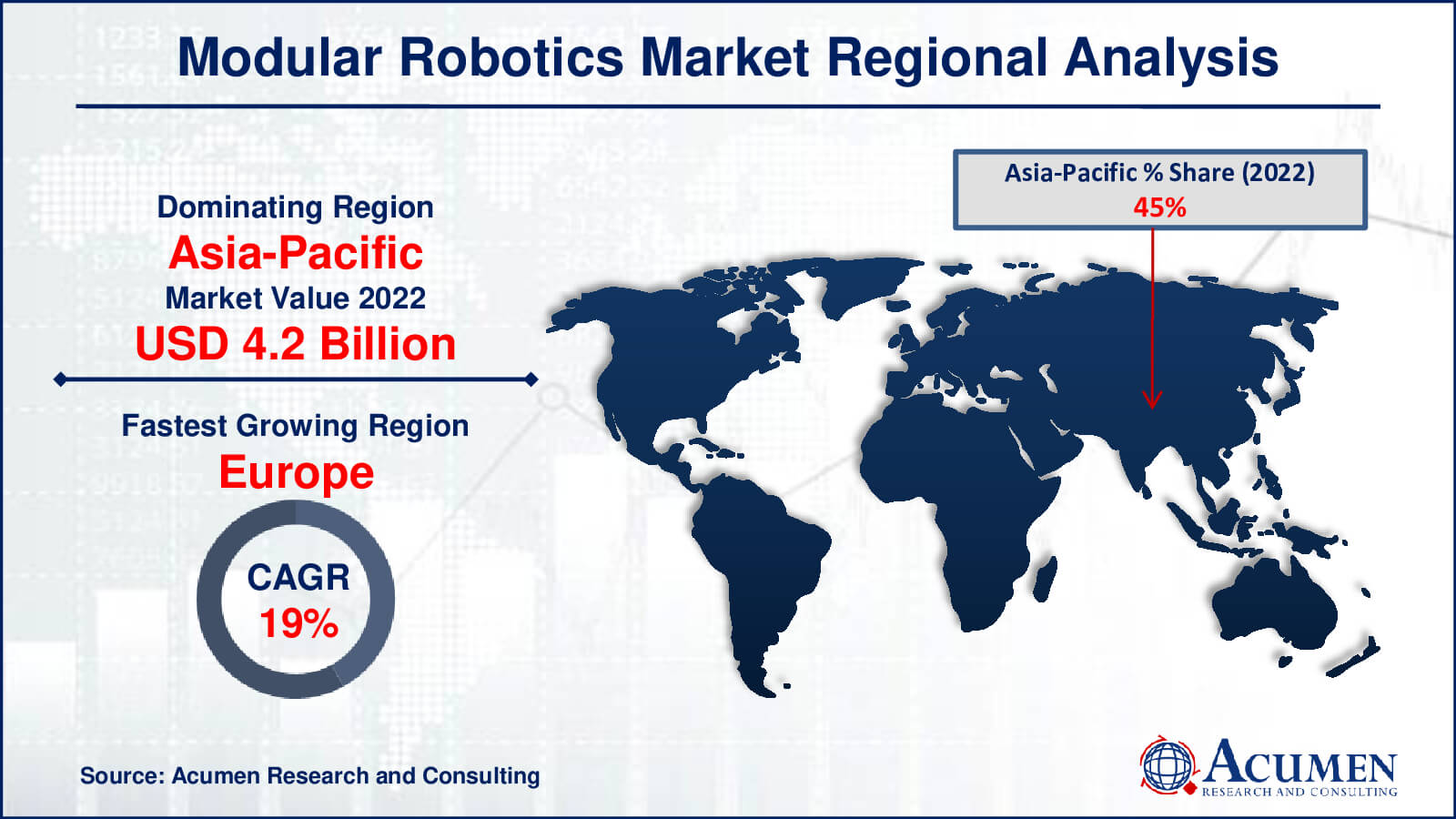March 2025
Modular Robotics Market Size accounted for USD 9.3 Billion in 2022 and is estimated to achieve a market size of USD 46.9 Billion by 2032 growing at a CAGR of 17.8% from 2023 to 2032.
The Modular Robotics Market Size accounted for USD 9.3 Billion in 2022 and is estimated to achieve a market size of USD 46.9 Billion by 2032 growing at a CAGR of 17.8% from 2023 to 2032.
Modular Robotics Market Highlights

The field of modular robotics involves modular magnetic block construction kits, allowing the assembly of small robots powered automatically. Reports indicate a projected surge in demand for modular robots between 2023 and 2032 across various industries. This rise is driven by the need to curtail production costs and the expanding application of modular robots worldwide. Developed markets like North America, Europe, and Asia-Pacific are poised to lead the global modular robotics market. Key players in these regions are introducing innovative modular robots, solidifying their positions as market leaders in this sector during the modular robotics industry forecast period.
Global Modular Robotics Market Dynamics
Market Drivers
Market Restraints
Market Opportunities
Modular Robotics Market Report Coverage
| Market | Modular Robotics Market |
| Modular Robotics Market Size 2022 | USD 9.3 Billion |
| Modular Robotics Market Forecast 2032 | USD 46.9 Billion |
| Modular Robotics Market CAGR During 2023 - 2032 | 17.8% |
| Modular Robotics Market Analysis Period | 2020 - 2032 |
| Modular Robotics Market Base Year |
2022 |
| Modular Robotics Market Forecast Data | 2023 - 2032 |
| Segments Covered | By Robot Type, By Component, By Configuration, By Hardware Design, By End-Use Industry, And By Geography |
| Regional Scope | North America, Europe, Asia Pacific, Latin America, and Middle East & Africa |
| Key Companies Profiled | ABB Ltd., A.C.M.I. spa, Aurotek Corporation, CMA Robotics Spa, DENSO, FANUC Corporation, Kawasaki Heavy Industries, Ltd., Mitsubishi Electric Corporation, Rethink Robotics GmbH, Universal Robots, and Yaskawa Robotics. |
| Report Coverage |
Market Trends, Drivers, Restraints, Competitive Analysis, Player Profiling, Covid-19 Analysis, Regulation Analysis |
Modular Robotics Market Insights
The global market continues to be influenced by the increasing adoption of industrial automation worldwide, particularly in the automotive and electronics sectors. Modular robots' flexibility to modify configurations based on manufacturers' or production lines' requirements further drives this trend. Asia-Pacific remains a dominant market leader, expected to expand significantly over the projected period. Notably, prominent economies in the Asia-Pacific region, including China, Japan, India, and South Korea, are increasingly embracing modular robotics in various industries. The growth of the modular robotics market is primarily driven by increased investment in industrial automation and the rising adoption of collaborative modular robots, driven by their benefits and features. Additionally, the anticipated surge in the adoption of the robotic-as-a-service model is poised to further stimulate market growth.
Various industries, including automotive, electrical and electronics, plastics, rubbers, chemical products, metals and machinery, food and beverage, precision engineering and optics, as well as pharmacology and cosmetics, utilize modular robotics for diverse functions such as welding and handling. Among these industries, the automotive sector stands out as the largest application segment for these robots. Ongoing technological advancements and increased investments in automation are promoting the use of various types of modular robots, including modular articulated robots, SCARA modular robots, and collaborative modular robots. Consequently, the overall market for modular robotics is experiencing notable growth.
A single robotic system is formed by interconnecting numerous modules in modular robotics. While modular robotic systems offer significant advantages, creating a modular robot can be challenging due to module ownership and compatibility issues among different manufacturers. This hardware module diversity often complicates the system integration process. To address this, several manufacturers, including acutronic robotics technology, are developing common integration platforms to streamline the integration of modular robotic systems.
The modular robotics market encompasses various robot types such as cobots, jointed robots, SCARA, and more. Cobots, or collaborative robots, operate alongside employees in industrial settings. Currently, there's limited demand for cooperative modular robots, but a substantial increase is anticipated during the forecast period. Cobots' diverse benefits contribute to this projected growth. Industries like automotive and electronics, heavily reliant on industrial robots, utilize collaborative robots to complement traditional industrial robot functions. Moreover, the global adoption of collaborative robots is poised to rise due to technological advancements in end-effectors like grippers, controllers, and diverse robotic modules.
Modular Robotics Market Segmentation
The worldwide market for modular robotics is split based on robot type, component, configuration, hardware design, application, and geography.
Modular Robotics Robot Types
In terms of modular robotics market analysis, the articulated modular robots sector dominates the market because to its versatility and adaptability across numerous applications. These robots have many rotary joints that allow for a great degree of flexibility in mobility and task performance. Their multi-joint architecture enables sophisticated manoeuvres and accurate operations in industries including as manufacturing, assembly, and material handling that require intricate and adaptive robotic activities. Because of their capacity to explore varied surroundings and accomplish sophisticated jobs, articulated modular robots are the most popular sector in the modular robotics landscape.
Modular Robotics Components
The global modular robotics market encompasses three main components, hardware, software, and services. Hardware modules in modular robotics vary extensively based on the task requirements, allowing for diverse configurations. Interconnected modules enable flexible adjustments in robot size and shape, tailored to specific tasks. Several companies offer task-specific attachments for modular robots, providing various end-effectors like clamps, grippers, and modules. These end-effectors come with specific specifications catering to various applications. The hardware segment dominates the market due to the interchangeability of components in modular robotics, offering extended lifespan and diverse applications.
Modular Robotics Configurations
The auto-configuration category dominates the modular robots market due to its efficiency and agility in fulfilling dynamic operational needs. Without the need for human intervention, automated configurations provide smooth adaptability and quick reconfiguration based on work needs. These systems use powerful algorithms and sensors to optimise their setups autonomously, increasing efficiency and lowering downtime. Auto-configured modular robotics are used in areas that require rapid adaptation and low operator intervention, such as manufacturing, logistics, and assembly lines. The automated nature of these configurations brings the Auto-Configuration sector to the forefront of the modular robots market.
Modular Robotics Hardware Designs
According to modular robotics industry analysis, the chain-based configuration is expected to the market leader in the market among hardware designs. Because of its interconnected, link-like structure, chain-based designs provide remarkable flexibility and adaptability. This design allows for the smooth movement and reconfiguration of modules, allowing for a wide range of robot shapes and functionalities. Its modular design enables for simple extension and alteration while maintaining structural integrity. Chain-based hardware is widely used in applications that need complex movements, such as production lines and difficult manoeuvring activities. The Chain-based segment is the frontrunner in the modular robotics hardware landscape due to its ability to offer diverse setups and quick adaption.
Modular Robotics End-User Industries
The automobile sector has been a leader in the use of modular robots for operations like assembly and shipping. The automobile sector has been a trailblazer in the integration of modular robots, transforming production processes via increased efficiency and precision. Modular robotic systems are widely used on automobile assembly lines for welding, painting, and component assembly, providing exceptional adaptability to changing production requirements and car models. These systems are crucial in material handling, logistics, and supply chain optimization by automating processes like transportation and quality monitoring.
The aerospace industry is also becoming more interested in modular robotic systems for assembly and maintenance. Furthermore, sectors such as electrical and electronics, food and beverages, and transportation and warehousing have seen a surge in the use of modular robots to improve efficiency.
Modular Robotics Market Regional Outlook
North America
Europe
Asia-Pacific
Latin America
The Middle East & Africa

Modular Robotics Market Regional Analysis
Asia-Pacific holds a significant share in the global modular robotics market in terms of revenue, primarily driven by the strong presence of major economies such as China, Japan, and South Korea. These countries house established players in industries like automotive and electronics, such as Mitsubishi Electric, Kawasaki Heavy Industries, Ltd., and FANUC CORPORATION. The region's dominance is further fueled by a robust electronics industry, rising sales from local robot suppliers, and increased industrial automation.
While Asia-Pacific leads, the European market is expected to witness rapid expansion during the predicted period. This growth stems from various established and emerging players like Universal Robots A/S, KUKA AG, and ABB. They drive industrial automation across sectors like automotive, food & beverage, and e-commerce in the region, innovating new modular robotic products and contributing to manufacturers' cost reduction efforts.
Modular Robotics Market Players
Some of the top modular robotics companies offered in our report include ABB Ltd., A.C.M.I. spa, Aurotek Corporation, CMA Robotics Spa, DENSO, FANUC Corporation, Kawasaki Heavy Industries, Ltd., Mitsubishi Electric Corporation, Rethink Robotics GmbH, Universal Robots, and Yaskawa Robotics.
Looking for discounts, bulk pricing, or custom solutions? Contact us today at sales@acumenresearchandconsulting.com
March 2025
December 2023
April 2021
October 2023